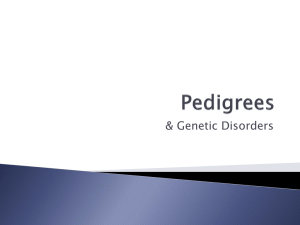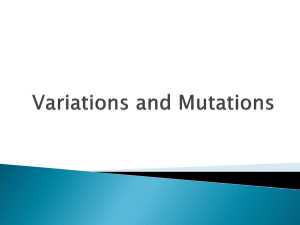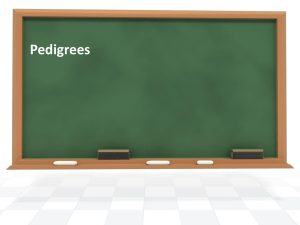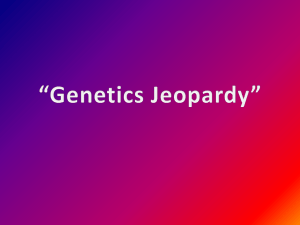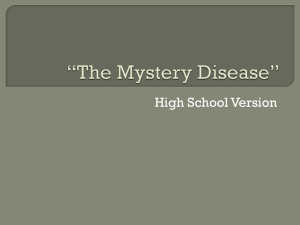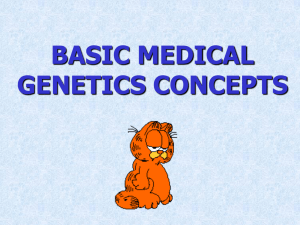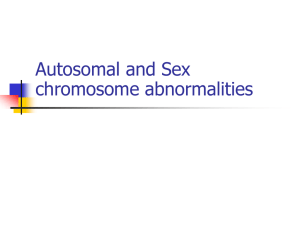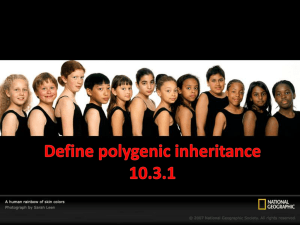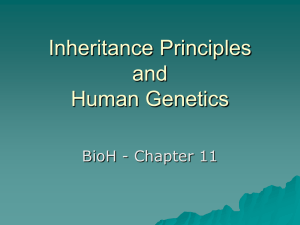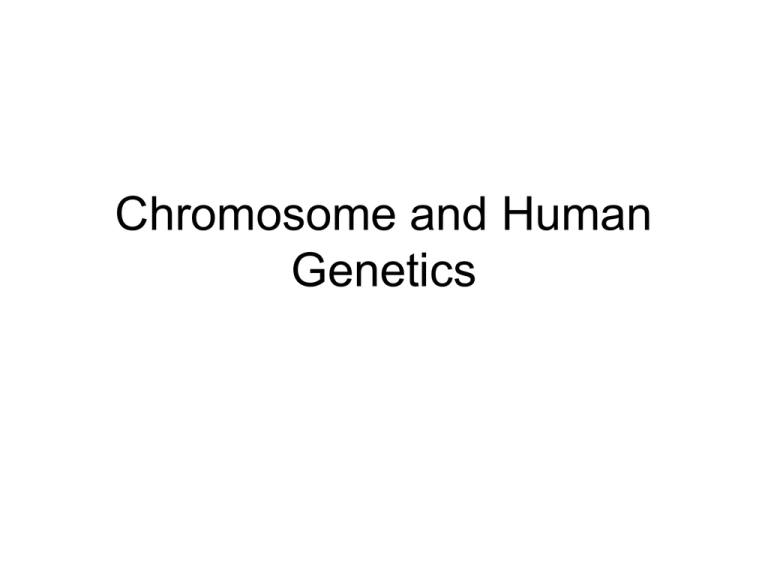
Chromosome and Human
Genetics
Human Genetics
• Constructing Pedigrees
• Inheritance Patterns
Because chromosome can be autosomes or sex
chromosomes, and because traits can be dominant or
recessive, we distinguish between 4 patterns:
1. Autosomal Recessive Inheritance
2. Autosomal Dominant Inheritance
3. Sex-Linked (or X-Linked) Recessive Inheritance
4. Sex-Linked (or X-Linked) Dominant Inheritance
What is a pedigree?
We study human genetics from past
history of families
A pedigree (family genetic history) a chart
of the genetic connection among
individuals.
Constructing a pedigree
A square represents a male
A clear square represents a normal male
A darkened square represents an affected
male
A circle represents a female
A clear circle represents a normal female
A darkened circle represents an affected
female
Constructing a pedigree
A single horizontal line connecting
both sexes represents mating
Vertical lines connect
parents to offspring
Generations are labeled
with roman numeral
This is a pedigree
Autosomal Recessive Inhritance
Because 2 normal parents have affected children the trait is
recessive.
Because both sexes can be affected the gene of the trait is located
on autosomes. The inheritance in this case is called autosomal
recessive
Autosomal Recessive Traits
•
•
•
•
•
•
Examples:
Phenylketonuria PKU
Albinism
Cystic Fibrosis
Sickle-cell Anemia
Let us study the first example:
Phenylketonuria - PKU
• Most people have a dominant gene that
enable them to break down the amino acid
phenylalanine by converting it into the
amino acid tyrosine.
• Those who have the recessive gene are
unable to do so. The phenylalanine they
ingest in food builds up in the body and is
broken down into phenylketones (mousysmelling substances are excreted in urine)
• Phenylketones cause nerve cells in the
brain to develop abnormally – mental
retardation.
• Genetically:
• A - normal a – affected (PKU)
• The gene is located on autosomes (#12),
therefore both sexes can be affected.
• The genotypes AA or Aa are normal
• The genotype aa is affected - PKU
• Can two normal parents have an affected
child?
• Yes
PKU test
This disease is known to be caused by an:
Autosomal recessive gene.
Autosomal Dominant Traits
Because one parent in every generation is affected, the affected trait is dominant.
And because both sexes can be affected the gene of the trait is located on
autosomes. The inheritance in this case is called autosomal dominant.
Huntington’s disease is a dominant
genetic disorder
Autosomal Dominant Inheritance
• Example: Huntington’s Disease
• Is the result of a dominant gene – A on
autosomal chromosome # 4 (in both sexes)
• This disease does not manifest itself until ages
35 to 50
• Symptoms include: progressive degeneration
and death of nerve cells, irregular and jerky
movement, and severe depression
Genetically
•
•
•
•
AA usually does not exist (lethal)
Aa affected
aa normal
In the pedigree of Huntington’s disorder
always one parent is affected.
Pedigree of a family with Huntington’s disease was
collected by Nancy Wexler in Venezuela in 1987
• Each child whose one parent is, or will
become, affected has 50/50 chance of
inheriting the disease. Those children
suffer years of anxiety and have to wait
until middle age to learn their fate.
• In the lab,they can detect the gene earlier
in the life of a person whose parent has
Huntigton’s disease.
X-Linked Recessive Inheritance
• Examples:
• Duchenne Muscular Dystrophy – DMD
• Hemophilia
X-Linked Recessive Traits
Because 2 normal parents have affected children the trait is recessive.
Because only males can be affected the gene of the trait is located on Xchromosome. The inheritance in this case is called X-linked (or sexlinked) recessive.
Pedigree of DMD, an X-linked gene
Who are affected? A. both sexes. B. males only. C. females only
As you see in the pedigree, two normal parents have an affected child,
so the trait is recessive. And because only males are affected, the gene
is located on X chromosome (X-linked inheritance)
The Royal Hemophilia Pedigree
DMD
• A degenerative
muscle condition that
strikes 1 out of 3500
boys.
• By age 5 the child
cannot stand up
easily.
• How a boy with DMD
rises
• At about age 20, the diaphragm muscles
degenerate, and the affected person can
no longer breathe.
Genetically
• D – normal d – affected
• The gene is located on X chromosome not
on Y
• X(D)X(D) normal woman
• X(D)X(d) normal woman (carrier)
• X(D)Y normal man
• X(d)Y affected boy
• Can a man be a carrier?
• NO
• If a normal man marries a normal woman X (D)
X (D), what is the probability that their children
will have DMD?
• O%
• If a normal man marries a carrier woman X (D)
X (d), what is the probability that their children
will have DMD?
• 25% - only boys
Human Chromosomes
• Karyotype Analysis
• Changes in the Chromosome Number
• Changes in the Chromosome Structure
Karyotype Analysis
• Preparation of metaphase chromosomes.
• To view human chromosomes, geneticists
remove white blood cells, stain and
photograph their nuclei, then cut the
chromosomes from photo with scissors
and arrange them in pairs in decreasing
size as shown in the next slide.
Changes in the Chromosome
Number
• Down Syndrome:
• People normally have 46 chromosomes:
22 pairs of autosomes and 1 pair of sex
chromosomes – XX or XY
• In case of Down Syndrome the cell has 47
chromosomes, 3 copies of chromosome
21 – Trisomy 21
• Syndrome is a set of symptoms that occur
together.
• This condition is characterized by lower
than average IQ. Heart malformation,
eyelid folds, and others.
Down Syndrome:Trisomy 21 was first
described in 1866 by J. Langdon Down
Correlation between maternal age and
the incidence of Down syndrome
• As women age,
the chances they
will bear a child
with Down
syndrome increase
Nondisjunction
• Errors in the distribution of chromosomes
during meiosis causes changes in the
chromosome number.
• When homologous chromosomes fail to
separate, the 2 chromosomes move
toward one pole of the cell, none to the
other cell.
• Nondisjunction may also affect the sex
chromosomes
– nondisjunction of the X chromosome creates
three possible viable conditions
• XXX female
– usually taller than average but other symptoms vary
• XXY male (Klinefelter syndrome)
– sterile male with many female characteristics and
diminished mental capacity
• XO female (Turner syndrome)
– sterile female with webbed neck and diminished stature
Nondisjunction of the X chromosome
Turner Syndrome
• A person with one X chromosome and no
Y chromosome (XO) is a sterile female.
• 2N=45
• This condition is characterized by by folds
of skin along the neck, a low hairline at the
nape of the neck, and failure to develop
adult sexual characteristics at puberty.
Klinefelter Syndrome
• A male with 2 X chromosomes and one Y
chromosome (XXY)
• 2N=47
• Affected people develop as sterile males
with small testes, long legs and arms.
Most manage well in society
Changes in the Chromosome
Structure
•
•
•
•
•
Deletion
Inversion
Duplication
Translocation
View “Changes in Chromosome Structure”
– animation in my Website
Deletion
• The loss of some segments of a
chromosome.
• Example: a normal sequence of genes on
a chromosome is: A B C D E F G H
• If this chromosome loses a piece
containing genes D E F, it becomes
shorter with following sequence:
ABCGH
• Most deletions are lethal or cause serious
disorders. For example, one deletion from
human chromosome 5 results in mental
retardation. When affected infants cry, they
produce sounds rather like a cat’s meow.
Hence cri-du-chat (cat-cry), the name of
this disorder.
Inversion
• A linear stretch of DNA within the
chromosome becomes oriented in reverse
direction.
• Normal sequence of genes is:
• A B C D E F G H before damage
• A B E D C F G H afterward
Duplication
•
•
•
•
•
•
Gene sequences are repeated many times
Normal sequence of genes before damage
ABCDEFGH
After modification it becomes:
A B C D C D C D C D E F G H or
ABCDEFFFFGH
Translocation
• It involves nonhomologous chromosomes
• A broken part of a chromosome becomes
attached to a nonhomologous
chromosome
• Sequence of genes in one chromosome is
A B C D, and E F G H in the second.
• After translocation the sequences will
become: A B E F and C D G H
Questions and Answers
Q. A chromosome’s gene sequence that was
ABCDEFGH before modification and
ABCDLMNOP afterward is an example of:
A. Translocation
Q. A chromosome’s gene sequence that was
ABCDEFGH before modification and
ABCDCDCDEFGH afterward is an example of:
A. Duplication
Questions and Answers
Q. A chromosome’s gene sequence that
was ABCDEFGH before damage and
ABCFG H after is an example of:
A. Deletion
Q. A chromosome’s gene sequence that was
ABCDEFGH before damage and
ABFEDCGH after is an example of:
A. Inversion

